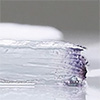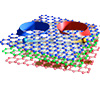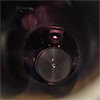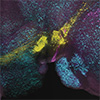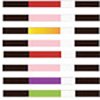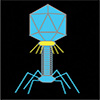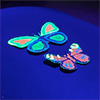Jan 24, 2025 (Nanowerk News) Hydrogels have a network of water-attracting (hydrophilic) molecules, allowing their structure to swell substantially when exposed to water. Researchers Daisuke Nakagawa and Itsuo Hanasaki from Tokyo University of Agriculture and Technology (TUAT) are looking into new options for making “kirigami hydrogels” that swell into complex...
engineering the first semimetallic Weyl quantum crystal
Jan 24, 2025 (Nanowerk News) An international team of researchers led by the Strong Correlation Quantum Transport Laboratory of the RIKEN Center for Emergent Matter Science (CEMS) has demonstrated, in a world’s first, an ideal Weyl semimetal, marking a breakthrough in a decade-old problem of quantum materials. Weyl fermions arise...
Physicists discover – and explain
Jan 24, 2025 (Nanowerk News) MIT physicists have created a new ultrathin, two-dimensional material with unusual magnetic properties that initially surprised the researchers before they went on to solve the complicated puzzle behind those properties’ emergence. As a result, the work introduces a new platform for studying how materials behave...
New atom-based thermometer measures temperature more accurately
Jan 24, 2025 (Nanowerk News) Scientists at the National Institute of Standards and Technology (NIST) have created a new thermometer using atoms boosted to such high energy levels that they are a thousand times larger than normal. By monitoring how these giant “Rydberg” atoms interact with heat in their environment,...
New method enables protein labeling of tens of millions of densely packed cells in organ-scale tissues (w/video)
Jan 24, 2025 (Nanowerk News) A new technology developed at MIT enables scientists to label proteins across millions of individual cells in fully intact 3D tissues with unprecedented speed, uniformity, and versatility. Using the technology, the team was able to richly label whole rodent brains and other large tissue samples...
Creating bioinspired structures with 3D printing
Jan 24, 2025 (Nanowerk News) When 3D printing was first introduced in 1985, it marked a major turning point for the manufacturing industry. In addition to being cheaper than traditional manufacturing technologies, it also promised the ability to customise designs and make prototypes on demand. While its technology is still...
Researchers pioneer DNA-tagged gold nanoparticles for targeted cancer treatment
Jan 24, 2025 (Nanowerk News) A team of researchers from the National University of Singapore (NUS) has developed a novel method to enhance the precision of cancer treatment using gold nanoparticles tagged with DNA barcodes. Led by Assistant Professor Andy Tay from the Department of Biomedical Engineering in the College...
Microscopy innovation turns viruses into precision measurement tools
Jan 24, 2025 (Nanowerk Spotlight) Measuring objects smaller than the wavelength of light challenges even the most sophisticated microscopes. When biologists study cellular structures just tens of nanometers wide - like the machinery that reads DNA or the channels that transport molecules - they need to know their measurements are...
Magnetic robot wings mimic monarchs, operate without electronics or batteries
Jan 24, 2025 (Nanowerk News) Researchers at the Technical University of Darmstadt and the Helmholtz Centre Dresden-Rossendorf have developed a revolutionary technology: flexible robot wings that are moved by magnetic fields. Inspired by the efficiency and adaptability of the wings of the monarch butterfly, they enable precise movements without electronics...
A wrinkle for light
Jan 24, 2025 (Nanowerk News) Stretching or bending, which is better? A lucky discovery led researchers to a new understanding of how ultrathin materials absorb and reflect light. The new model — if confirmed — could change the way ultrathin materials are developed and used. The discovery came when researchers...

